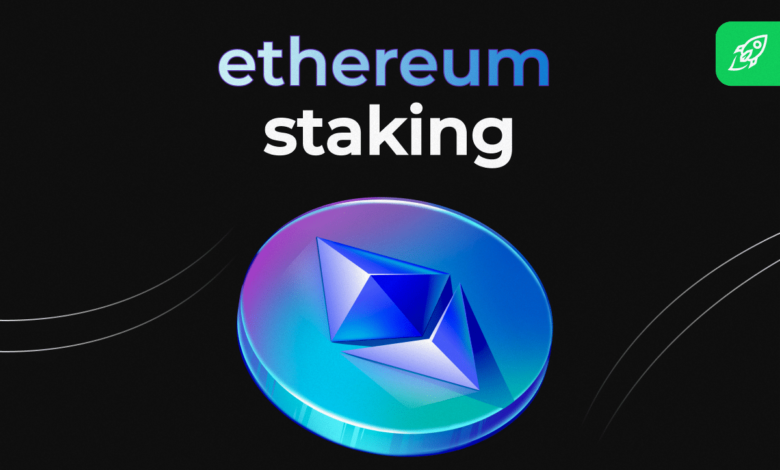Ethereum Staking: An Overview

Although it may surprise quite a lot of people, Ethereum has been stakeable long before the Merge. Ethereum staking has indeed been live since December 2020, but withdrawals have always been planned to be introduced only after the Shanghai update, which took place in April 2023.
The process of staking crypto assets involves users actively participating in the transaction validation process, just like mining. Unlike mining, however, it doesn’t require copious amounts of computing power and doesn’t have intense hardware requirements — instead, it requires users to lock up their funds. In the case of ETH staking, that will be Ether. Ethereum staking can be a great way to earn some passive income.
What Is Ethereum?
After the launch of Bitcoin, crypto developers sought to extend the capabilities of the Bitcoin blockchain to be more than just a payment option and to give it other use cases beyond peer-to-peer payments and financial services. They saw value in its underlying technology.
One of those people was Vitalik Buterin. He and others have been working on a more flexible blockchain that runs scripts and programs and eventually enables applications that would allow for different decentralized uses. As a result, he created Ethereum.
These days, Ethereum is, without a doubt, one of the world’s most famous and biggest crypto projects. However, it is much more than yet another cryptocurrency or altcoin: it is considered by many to be a powerful world computer capable of supporting a complex web of different apps and projects. The programs — pieces of code, or scripts — running on the Ethereum blockchain are commonly referred to as smart contracts.
Smart contracts are often used in the financial industry. The technology utilized by the Ethereum network makes it exceedingly easy to combine the main principles of decentralization with time-tested business models. This allows the creation of actually decentralized financial systems, DeFi.
Since smart contracts are financial products and services, there are so many ways to use them. DeFi applications can even be considered a revolution in their own right, with a total value of around $1 billion at the time of writing this article — and the number only keeps on growing as the industry is developing quite rapidly.
What Is Ethereum Staking?
Staking is the act of locking up your digital assets. It is available for a wide variety of cryptocurrencies, including Ethereum.
Although Ether used to be a proof-of-work crypto, it has switched to a proof-of-stake consensus mechanism. This means that instead of miners solving complex equations to validate transactions and create new blocks, the network now relies on individuals who stake their Ethereum as a form of collateral.
So, how does it work? If you’re well-acquainted with digital assets and have at least 32 ETH in your software or hardware wallet, you’re eligible for Ethereum on-chain staking. By setting up a staking node, you become a validator. Your role? To batch transactions into new blocks on the execution layer, keep an eye on other validators, and ensure everyone plays fair. And for your diligence, the network rewards you. These are called validator rewards, which are a combination of native block rewards and transaction fees.
This sounds fantastic for those with the requisite 32 ETH, but what if you don’t have that much? Enter cryptocurrency exchanges and pool staking. Many crypto exchanges offer staking services where you can pool your Ethereum with others. In exchange for rewards, you give a small percentage to the service providers. But always remember, when staking through a crypto exchange, the exchange rate and your access to immediate liquidity might differ from solo staking. Some exchanges even offer a token swap, turning your staked ETH into a liquid staking token. This can be traded or used while your original Ethereum remains staked.
How to Stake Ethereum
While one can stake Ethereum in different ways, there is no one best option: the choice will depend on how much ETH you are willing to stake and what risks you are ready to take.
Now, let’s take a closer look at the process of ETH staking.
How Does Ethereum Staking Work?
There are three main ways to stake Ethereum. Here is their brief overview.
Solo Staking
This is probably the best option for people who have a bigger starting fund. If you have at least 32 ETH, you should consider this possibility — it offers the biggest rewards as you don’t have to share them with anyone else.
When solo staking Ethereum, you will get rewards for batching transactions into new blocks or, alternatively, overseeing the work of other people who validate transactions to ensure the security of the Ethereum network.
Those users who solo staked ETH before the Merge (formerly known as Ethereum 2.0) are also liable to receive unburned transaction fees for the blocks they proposed.
The high initial investment is not the only downside to Ethereum solo staking. It carries additional risks, such as, well, constantly having your hard-earned ETH at stake. There are also penalties for going online. Additionally, it requires you to run some rather demanding hardware that can execute both the Ethereum and consensus clients. You will need a stable Internet connection too.
Staking ETH as a Service
This option is basically solo staking but for people who aren’t technically inclined or don’t want to bother running their own validator node, which can be quite a daunting task.

If you staked ETH as a service, it doesn’t mean you did someone some favors — no, it involves letting third-party operators run your validator nodes for you. Staking as a service is usually referred to as “SaaS.”
Just like solo staking, this option requires you to have 32 ETH that you can afford to lock up. However, unlike when you stake ETH on your own, you won’t have to go through the whole set-up process by yourself. A third party will guide you through everything, one step at a time. You will get full rewards minus the fees paid to the third-party operator.
The biggest downside of this option is very clear: you will have to hand over access to your funds to someone else. Staking ETH as a service involves you uploading your signing keys to an operator. Fortunately, some services allow you to keep your withdrawal and transfer keys private, but not all of them offer this option.
Other than counterparty risk, SaaS is mostly similar to solo staking in terms of the ways you can lose your funds. After all, even when using a service to manage your validator node, you are still staking your own ETH.
Pooled Staking
Just like pool mining, pooled staking allows you to earn the rewards associated with the respective activity by pooling your resources together with others. This method of staking ETH has the lowest minimum requirements — the starting point can be as little as 0.01 ETH.
You can deposit your crypto funds directly to a pooled staking platform or simply trade for the staking liquidity token of the platform you are planning to use. As a result, pooled staking is a lot easier than solo staking, as you won’t have to set up any nodes yourself.
There are different pool staking services. Rewards and their method of accumulations differ platform by platform, but there is one thing all staking pools have in common: counterparty risk. Be careful with whom you entrust your ETH to.
Centralized Exchanges
You can also stake ETH on some centralized exchanges (CEXs). However, the official Ethereum website discourages people from this staking method, as it jeopardizes the decentralized nature of the Ethereum network and makes it less secure.
If all the other options above do not suit your needs and preferences, you can, of course, go for CEX staking — that’s up to you. It is still a great way to make money off of your Ethereum coins with medium risk.
What Are the Minimum Requirements to Stake Ethereum?
For solo staking and staking as a service, the minimum requirement is 32 ETH: that’s how much you need to set up an Ethereum node.
For pooled staking, it will largely depend on the project you are joining. Some pools have minimum requirements of as low as 0.01 ETH.
What Software Do I Need to Run to Stake ETH?
It depends on what staking method you go for. If you plan on running a node, you will need an execution client, a consensus client, and validator software. When joining a pool on staking platforms, you will usually be asked to install its platform-specific software. Centralized exchanges handle everything on their platforms, with no extra software required to be installed.
Can I Withdraw My ETH Staking Rewards?
Ever since the Shanghai/Capella upgrade took place on April 12, 2023, it became possible for users to withdraw their staked Ethereum. Reward payments are processed automatically for all active validators with an effective account balance of 32 ETH. Reward payouts on crypto exchanges and pool staking services depend on the platform.

How Much Can I Earn by Staking Ethereum?
Just like most other things we’ve talked about in this article, ETH staking rewards will depend on your chosen staking method. The fewer third parties are involved in your staking operation, the more you will be able to get. Generally, the APR (Annual Percentage Rate) is slightly higher for running a node vs. pool staking.
You can use one of the many calculators available online to calculate your approximate potential staking rewards.
What Is an Ethereum Stake Pool?
An Ethereum stake pool is a service that lets you stake ETH in a pool by joining forces with others. This option has lower rewards but is the best way for someone who doesn’t have 32 ETH to stake Ethereum.
When choosing a staking pool, pay attention to things like their APR, fees, contract length, the total amount of ETH staked in that pool, and more. Always make sure to read reviews before you commit to using a service — there are scammers out there.
Risks Associated with Staking Ethereum
There are several risks associated with Ethereum staking. First of all, there is always the possibility that a piece of software of the underlying smart contracts may be hacked — some people prefer to use malicious and criminal practices to earn rewards. Your staked ETH is very similar to the coins in your wallet and can also be stolen.
Other than criminals, there is also ever-present counterparty risk if you’re staking with the help of any third party. These services make it much easier and accessible to earn staking rewards but do come with threats like key or funds mismanagement, scams, and so on.
Some penalties can also result in fines: if you want to earn more ETH and avoid ending up with a loss, be careful to DYOR and follow the rules or only work with third parties that have proven themselves to be reliable.
Why Stake Ethereum? The Main Benefits for Validators and The Ethereum Network
There are many reasons why anyone would want to stake their Ethereum funds. The benefits staking offers are attractive to both those who care only about their personal profit and the people who want to improve the Ethereum ecosystem. Here are some of the reasons why you should consider ETH staking.
- Attractive Reward Rate. For starters, the reward rate is appealing. Active validators who perform their duties efficiently are rewarded handsomely. It’s a win-win. You offer your Ethereum as collateral to the network, and in return, you receive compensation in the form of newly minted Ethereum tokens and transaction fees.
- Security and Prevention of Malicious Behavior. Staking serves a dual purpose. Not only does it offer rewards, but it also fortifies the network against malicious behavior. Validators have a stake (quite literally) in the game. Any deviant act or attempt to validate false transactions would mean a significant loss in their staked tokens. This vested interest ensures the utmost integrity among network validators.
- Decentralization and Network Strength. As more individuals participate as network validators, Ethereum becomes more decentralized. A broad base of individual validators ensures that the power doesn’t rest in the hands of a few, promoting trust and resilience in the network.
- Enhanced Network Speed and Efficiency. With a growing number of active validators, transactions get validated faster. Apart from individual validators, this improved efficiency benefits users who experience quicker transaction times. It can also boost the price of Ethereum (ETH).
Staking Ethereum is more than just a passive act of locking in your assets. It’s an active commitment to the network’s longevity and health. When you stake your ETH, you’re not just betting on its future value but also actively participating in securing and fortifying the Ethereum ecosystem.
FAQ
Is ETH good for staking?
Depends on your investment goals but generally, yes. After all, it secures the Ethereum network, and the rewards can be quite good.
How often are ETH staking rewards paid?
In general, they are paid every 6.5 minutes. However, you may not be able to withdraw them right away. If you want to start earning rewards and withdraw them immediately, the best option would be to join a staking pool that lets you get liquidity staking tokens.
Can I stake less than 32 ETH?
Yes, you only need 32 ETH if you intend to run your own node. Pooled staking and centralized exchanges have much lower minimums.
Is there an Ethereum staking minimum or maximum?
There’s no maximum; however, if you are about to run your own node, you will generally need to invest 32 ETH. So, if you already run one node, you will need 32 more ETH to increase your stake. The minimum is thus also 32 ETH unless you’re joining a staking pool or using a CEX.
Disclaimer: Please note that the contents of this article are not financial or investing advice. The information provided in this article is the author’s opinion only and should not be considered as offering trading or investing recommendations. We do not make any warranties about the completeness, reliability and accuracy of this information. The cryptocurrency market suffers from high volatility and occasional arbitrary movements. Any investor, trader, or regular crypto users should research multiple viewpoints and be familiar with all local regulations before committing to an investment.





